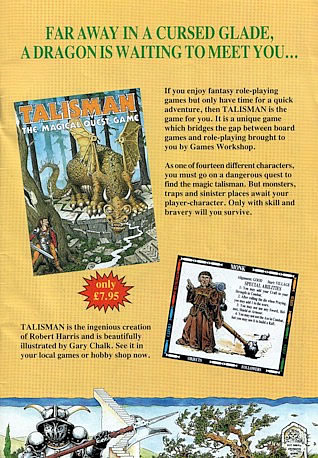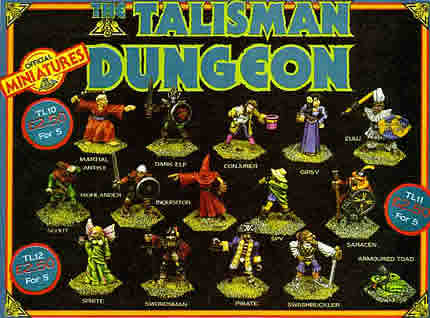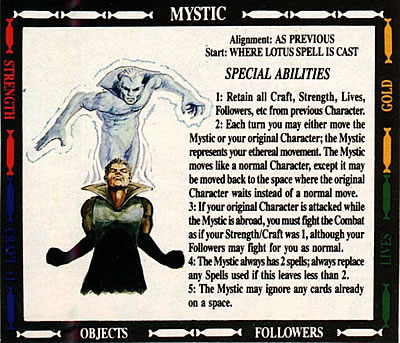
THE HISTORY OF TALISMAN
It has been nearly 25 years since the appearance of the first ever edition of Talisman and the popular game has been through many changes in that time. Here we take a look at the development of Talisman from it's development up until it's current incarnation.
 Talisman creator Bob Harris first came up with the idea for the famous Magical Quest boardgame after being introduced to Dungeons and Dragons as a student. Combining his passion for adventuring in a high fantasy imaginary realm with a design for a game in which teachers at a school moved towards the centre of the board in the hope of becoming the headmaster, Bob stumbled upon the basic concepts for the game that would eventually become Talisman.
Talisman creator Bob Harris first came up with the idea for the famous Magical Quest boardgame after being introduced to Dungeons and Dragons as a student. Combining his passion for adventuring in a high fantasy imaginary realm with a design for a game in which teachers at a school moved towards the centre of the board in the hope of becoming the headmaster, Bob stumbled upon the basic concepts for the game that would eventually become Talisman. Bob wanted the characters in the game to be unique and have some degree of personality, so that they were more like characters in a roleplaying game than pieces in a boardgame. With this in mind he gave each of them two or three special abilities, a moral compass of Good, Neutral or Evil and a pair of characteristics: Strength to represent their physical prowess and combat skills, and Craft to represent their mental, magical and spiritual resources.
As the characters grew more powerful they would be able to make their way towards the centre of the board. On their quest the players would meet powerful and dangerous monsters, discover friends and magical objects, and meet strange beings. Finally, when they have gained sufficient power, they can cross the final and most dangerous region. However, before they can do this they first need to find one of the magical Talismans that will allow them to pass through the deadly Portal of Power unharmed! At this point Bob was calling the game “Necromancer”, and a Necromancer's Isle lay at the centre of the board where a player would gain the ability to kill off his rivals.
TALISMAN IS RELEASED!
After playtesting the game extensively with friends, Bob contacted Ian Livingston and Steve Jackson of Games Workshop and sent them a prototype of the game. They wanted to make some minor alterations, including changing the name to Talisman. The first edition of Talisman was released at Games Day 1983. Most of the cards in this first edition were in black and white, though the board by Gary Chalk was fully coloured and set an early high benchmark for the game’s production values. Nobody at Games Workshop was quite ready for Talisman’s runaway popularity. Print run after print run sold out. Soon plans were afoot to produce a glossier, full colour second edition, which was released in 1985 and sold even better than the first. There just seemed to be no end to the demand for the game!
 |
A White Dwarf advertisement for the first edtion of the game. |
Games Workshop were also deluged with letters from players asking for new cards and characters, or suggesting their own ideas for the game. Bob Harris had also mentioned that he had designed the game in such a way that expansion sets could be added to it if there should be a demand for such things, and began work on the Talisman Expansion Kit. At about this time an article appeared in White Dwarf Magazine (waaay back in issue 72) extolling the virtues of Talisman, written by Citadel sculptor Ally Morrison.
THE JEWEL IN THE CROWN, A LOOK AT TALISMAN
by Alastair Morrison
I tend to buy games for one of two reasons. Either it is a good, playable system, or it has a great box! I admit it was the second reason that initially attracted me to Talisman, however, once I looked inside I discovered that not only was the artwork excellent but the game was good and playable too.
For those of you unfamiliar with the game, the board itself consists of three distinct regions. The outermost region, coloured in green, is easiest to travel through, followed by the blue region and the buff inner region, wherein lies your goal – the Crown of Command. In the game, each player takes on the role of a Warrior, Wizard or Priest, each of whom, each of whom has special powers, and sets off on a quest to find the magic Talisman. The regions on the board are the areas of ‘countryside’ travelled through, and each region is actually sub-divided into squares, each of which has its own title (eg: Chapel, Hills, etc) and encounter instructions. Effectively Talisman is a regulated role-playing boardgame.
There are fourteen character cards and pieces which depict the individual adventurers: a Prophetess, Druid, Warrior, Ghoul, Priest, Wizard, Sorceress, Monk, Troll, Elf, Thief, Assassin, Minstrel and Dwarf. Each card gives details of the character’s unique abilities. For example, the Prophetess can always begin the game with one spell, always retain one, and look at other players’ spells at any time during the game. Character cards also show your initial Strength, Craft, Lives, Gold, Alignment and starting location.
Over a period of time, each character seems to develop its own personality, regardless of who plays them. One example is the Troll; not the most personable of characters, but one who tends to develop Massacrevellian (rather than Machiavellian) tactics. After all, why be subtle and devious when pure force will get you the same results – and faster!
Spell cards are another important facet of the game – each one gives specific details as to the type of spell you can cast in the course of a game. For the greedy, the Acquisition spell is a good one, although my favourite has to be Temporal Warp – a spell that enables you to take three turns in a row.
One unpleasant aspect of the game is being turned into a Toad as a result of a spell. This invariably happens when your character has acquired enough Gold to bury Fort Knox, an armoury that would overburden the hordes of Genghis Khan and enough Followers to fill a football pitch. Since a Toad cannot carry anything, all his worldly wealth remains on the space he occupied when the spell struck. This usually results in a mad scramble by the other players to be the first to reach this unexpected treasure trove. All the poor Toad can do is sit and croak his objections in vain for the next three turns.
After playing Talisman on numerous occasions with anything from two to six players, it becomes obvious that it is ideally suited to the three or four player game since it keeps the playing time down to about two and a half hours yet still offers an interesting challenge.
Having said that, the six-player game is perfect for role-players, allowing plenty of character interaction and development as each player seeks the Weapons, Objects and Talismans that are now in short supply. This is a game of back-stabbing, cheating and corruption, with spells, curses and blood flying across the board. An interesting variant is to have only one Talisman. The player who eventually gets it would be sure to spend most of the game being pursued by a bunch of frothing maniacs bent on grievous bodily harm (at the very least!).
 |
Just a few of the great Citadel Miniatures that were produced for the second edition of the game. |
EXPANSIONS GALORE!
The Talisman Expansion Kit added new spells, adventure cards and characters to the game, and also proved successful. It was followed by Talisman: The Adventure, which also included new cards and characters but also some alternative ending cards to make the endgame less predictable. Expansion sets were not the only products that were borne out of Talisman’s success, Citadel miniatures produced a very characterful set of Talisman figures that could be used as playing pieces, and there was even a computer version. Bob Harris delivered another expansion set, The Talisman Dungeon, which added a secondary board to the game that the players could move into with its own set of special Dungeon cards that were picked instead of Adventure cards. Taking a trip into the Dungeons was more dangerous than exploring the normal board, but offered an opportunity to reach the Crown of Command ahead of your opponents if you were lucky. The Dungeon was quickly followed by Talisman Timescape, which included a new board, adventure cards and characters that allowed players to leave the Talisman world to adventure into strange and exotic science fiction settings. The next expansion, Talisman City returned to the Talisman world, providing a board and cards that recreated an entire fantasy city, filled with plenty of places for the players to spend the gold they had collected on their adventures. A set of “Master Level Characters”, the Mystic, Herald, Templar and Champion of Chaos appeared in White Dwarf 115. Your starting character could become one of these powerful individuals by achieving certain criteria in the game. The sixth and last expansion for the second edition of the game was Talisman Dragons, in which the land had been conquered by the evil Dragon King, and the players had to deal with eighty new adventure cards on their way to defeating him and rescuing the Crown of Command.
 |
The mystic was one of a quartet of Advanced Characters which appeared in White Dwarf 115. |
By now the game had been licensed to companies in France and Germany, and was being played in Scandinavia, the Middle East, Eastern Europe, Australia and the USA. Talisman was getting rave reviews and one magazine even listed it as one of the top ten games of all time. It was also a regular winner of the “Best Fantasy Board Game” award at Games Workshop’s annual Games Day.
“The reason for Talisman’s enduring and wide-ranging appeal is that it serves as an excellent introduction into the world of fantasy gaming,” wrote Jervis Johnson, in a White Dwarf article written to commemorate ten years of Talisman. “Talisman is easy to understand and can be played by all the family, combining many fantasy game themes with the luck and tactics of a traditional boardgame. The game is simple to learn, difficult to master, entertaining, challenging and always great fun to play.
“Although Talisman is designed to be a light-hearted and entertaining game, it still provides plenty of opportunities to carry out cunning plans and clever ploys that will confound your opponents! This makes it an excellent game for even the most hardened and experienced gamer.”
THE THIRD EDITION
In 1994 Games Workshop produced a large, glossy third edition, which included a set of plastic playing pieces and proper playing cards with the game, as well as a pared down ruleset designed by Jervis Johnson that was easier to learn and quicker to play. This edition of the game was tied closer to Games Workshop’s Warhammer Fantasy Battle and many of the playing pieces were recognizable to players of Warhammer or Warhammer Quest. Dungeon of Doom was the first expansion set released for the third edition of the game. The set allowed the players to enter two of the realms that surrounded the land of Talisman, the Dungeon of the dread Lord of Darkness, and the Mountain realm of the fierce Eagle King. This was shortly followed by the City of Adventure, which also included a new board for each of two realms, the City realm of the Emperor and the Forest realm of the deadly Wraith Lord. A final expansion, The Dragon’s Tower, added a structure to the centre of the board topped by a plastic dragon, which made the endgame more dangerous and less predictable. Jervis wrote a number of articles for the new edition that appeared in White Dwarf, including a number of characters that didn't appear in any of the boxed sets, such as the Necromancer and the Wood Elf Wardancer.
 |
The third edition of the game was closely linked with the imagery developed for Warhammer Fantasy Battle. |
THE NEW EDITION!
Black Industries are very excited to announce the launch of a brand new edition of Talisman. Releasing in October 2007, the classic Talisman game is back and it’s better than ever!
Talisman remains a cult fantasy board game for 2 – 6 people. Players control a myriad of characters from a heroic warrior to a powerful sorcerer. In this perilous adventure, play centres around the journey of these gallant heroes to find and claim the Crown of Command, a magical artefact with the power to destroy all rivals and make the bearer the true ruler of the kingdom. Only with strength, courage, and wisdom will players be able to survive the ultimate test and beat their opponents to victory.
Talisman’s enduring appeal is that of a traditional fantasy boardgame and more. Players soon find themselves taking part in an epic quest of brave deeds, daring encounters and death defying battles, which deepens as the game unfolds.
Marc Gascoigne, Head of Black Industries, said, “This is the best edition of Talisman we have ever produced. It’s the return of a genuine classic fantasy game, and I’m proud to be announcing its comeback. The gameplay is based on the very best aspects of the previous editions, but with added extras such as the all new speedy play rules written by the legendary Rick Priestley. The game looks fantastic, with fabulous new artwork. I know fans old and new will love this edition.”
 |
The great new edition of Talisman in all its glory. |





